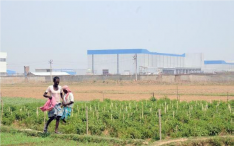
Singur is popularly called the granary of West Bengal. This particular piece of land in Singur is highly fertile and is home to around 5,000 peasant families. Located in the Hooghly district of West Bengal, Singur came into the limelight for its peasants’ movement in 2006.
The government acquired 1,253 acres (500 hectares) of multi-cropping agricultural land and leased it at a highly subsidized rate to MNC Tata through the West Bengal Industrial Development Corporation (a state government enterprise) to construct their car manufacturing factory. The land was acquired in accordance with the colonial Land Acquisition Act of 1894.
The compensation package proposed by the government was refused by the peasants as the eviction would deprive them of their livelihood and their indigenous culture and ways of life. The movement of Singur peasant against cultivable land acquisition was intensified all over India inspiring various land rights movements since 2006.
The people of Singur actively protested against the government’s acquisition notice. They formed the ‘Singur Krishi Zamin Raksha Committee’ (Save Agricultural Land Committee) and resisted the acquisition of land. IMSE and Food First Information and Action Network (FIAN) West Bengal took the initiative to set up a ‘Committee to Assist the Struggle of Singur Peasants Against Eviction’ comprising leading civil society actors of the State for extending all-round cooperation and assistance to the struggling peasants in Singur.
During the movement, the peasants had to face brutal attacks and violations of human rights leading to loss of lives. With active assistance from the larger civil society, the peasants’ resistance movement against the eviction gained strength day by day and the struggling peasants refused to accept the acquisition notification. They vowed to continue their protest till death without giving even an inch.
While the resistance on the ground continued, activist groups like FIAN West Bengal in collaboration with IMSE launched a two-pronged approach in support of the movement by actively taking part in the movement and taking the matter to the judiciary. The judicial move inspired many other organizations to join the legal battle leading to initiating the court proceedings. When Calcutta High Court was unable to give much relief to the peasants, activist groups moved to the Supreme Court of India in New Delhi. After almost a decade-long judicial battle, finally, on 31 August 2016, the Supreme Court of India gave a historic judgment in favor of the peasants in Singur and ordered the government to return the entire land to the peasants with adequate compensation for the loss incurred for the last 10 years.
Due to the massive movements of the peasants in Singur and also in other parts of the country, the said Land Acquisition Act of 1894 has now been replaced by a new ‘Land Acquisition, Rehabilitation, and Resettlement Act, 2013’. IMSE and FIAN West Bengal took an active part in organizing a series of Consultations to provide inputs in drafting LARR when the new Land Acquisition Act was amended.
After ten long years when the issue is being resolved, IMSE and FIAN West Bengal decided to organize an International Fact-Finding Mission (IFFM) comprising of national and international participants to revisit Singur and document the positive change with the following aims:
- To meet the local peasants organizations and congratulate them on their victory
- To understand the nuances of restoration of livelihoods (returning of land, compensation, livelihoods of sharecroppers and wage laborers) in Singur
- To capture any existing demands of the peasant groups
- To contextualize the Singur case in the present-day proposed agrarian reform initiatives of the central government (including land lease act)
The main findings of the IFFM are:
- In the process of returning land taken from peasants of Singur for the Tata Motors Nano Project, the Government has been able to make more than 100 acres land cultivable and complete plot demarcation for 325 acres as on date
- Following the Supreme Court Verdict, a land survey within the project area is being carried out expeditiously with the help of a drone and GPS satellite mapping for aerial surveys.
- The peasants whose land was forcibly grabbed received their land back along with a compensation of INR 2.80 lakh per bigha.
- The farmers who willingly parted away with their land have also got back their land and were not required to return the compensation amount they received earlier.
- There is no discrepancy in the process that was followed in returning land back to the peasants. When the land was acquired it was based on GPS and surveys. The same method was followed while returning the land to the peasants.
IMSE firmly believes that the Right to Food is a fundamental human right and the Right to Land and access to food-producing resources for smallholders are an integral part of it.
Established in 1973, the Institute for Motivating Self Employment (IMSE) works to strengthen grassroots level governance and effective participation of the poor, particularly women in the decision-making process. IMSE has been able to develop a network of more than 8,000 strong women groups in West Bengal, Odisha, and Jharkhand with village-level units in more than 700 villages in Eastern India. IMSE is one of the farmers’ organizations that are part of MTCP2 India. #

Comments are closed